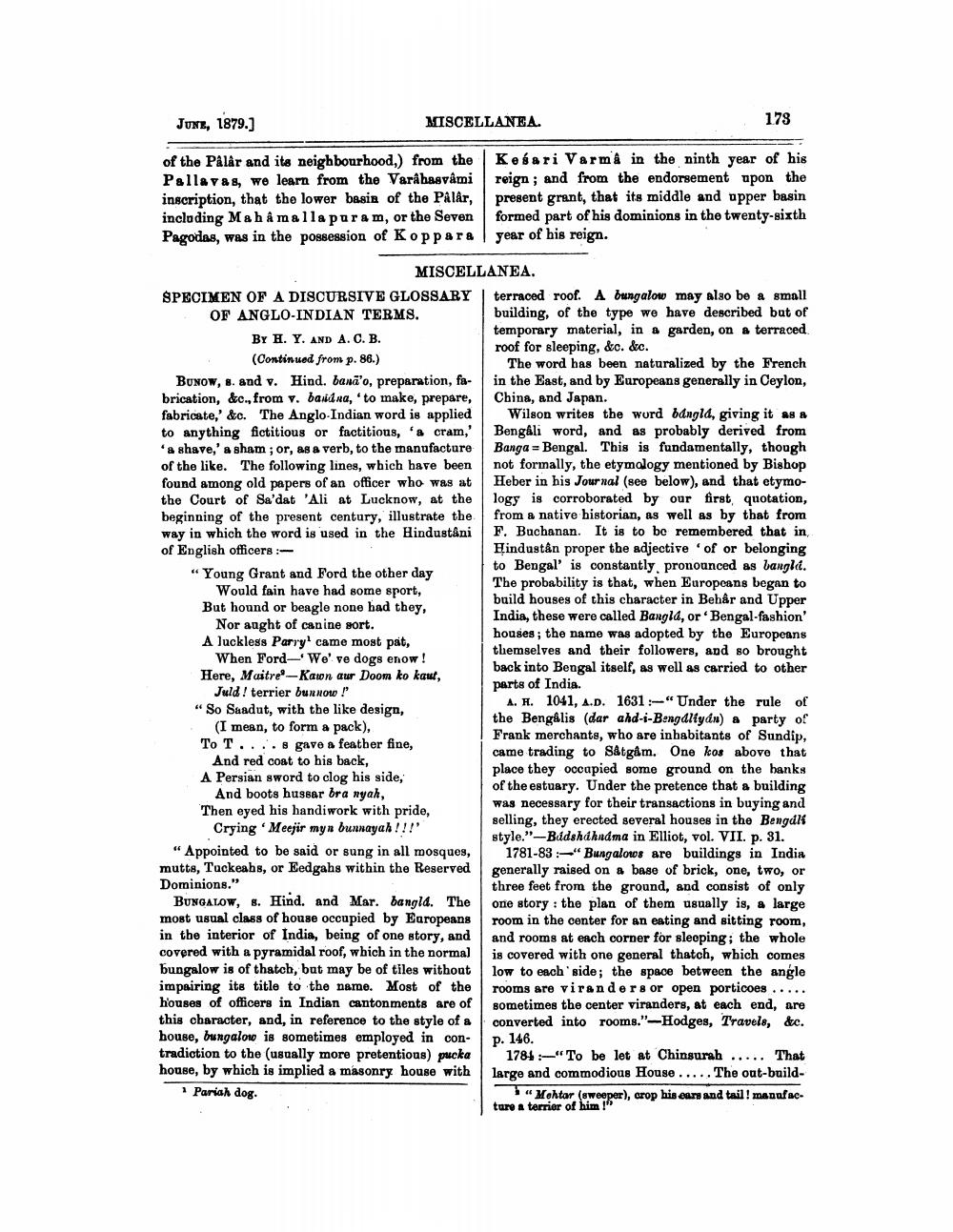________________
JUNE, 1879.]
MISCELLANEA.
178
of the Palar and its neighbourhood,) from the Palla vas, we learn from the Varáha vámi inscription, that the lower basin of the Palar, including Mah åmalla puram, or the Seven Pagodas, was in the possession of Koppara
Kesari Varm in the ninth year of his reign; and from the endorsement upon the present grant, that its middle and upper basin formed part of his dominions in the twenty-sixth year of his reign.
MISCELLANEA. SPECIMEN OF A DISCURSIVE GLOSSARY terraced roof. A bungalow may also be a small OF ANGLO-INDIAN TERMS.
building, of the type we have described but of
temporary material, in a garden, on a terraced BY H. Y. AND A. C. B.
roof for sleeping, &c. &c. (Continued from p. 86.)
The word has been naturalized by the French BuNow, S. and v. Hind. banā'o, preparation, fa- in the East, and by Europeans generally in Ceylon, brication, &c., from v. baina, 'to make, prepare, China, and Japan. fabricate,' &c. The Anglo-Indian word is applied Wilson writes the word bangld, giving it as a to anything fictitious or factitious, '& cram,' Bengali word, and as probably derived from 'a shave,' a sham; or, as a verb, to the manufacture Banga = Bengal. This is fundamentally, though of the like. The following lines, which have been not formally, the etymology mentioned by Bishop found among old papers of an officer who was at Heber in his Journal (see below), and that etymothe Court of Sa'dat 'Ali at Lucknow, at the logs is corroborated by our first quotation, beginning of the present century, illustrate the from a native historian, as well as by that from way in which the word is used in the Hindustani F. Buchanan. It is to be remembered that in of English officers :
Hindustan proper the adjective of or belonging
to Bengal' is constantly. pronounced as bangld. “Young Grant and Ford the other day
The probability is that, when Europeans began to Would fain have had some sport,
build houses of this character in Behår and Upper But hound or beagle none had they,
India, these were called Bangla, or Bengal-fashion Nor aught of canine sort. A luckless Parry came most pat,
houses; the name was adopted by the Europeans When Ford-'We've dogs enow!
themselves and their followers, and so brought Here, Maitre-Kawn aur Doom ko kaut,
back into Bengal itself, as well as carried to other Juld! terrier bun now !
parts of India. "So Suadut, with the like design,
A. H. 1041, A.D. 1631 :-"Under the rule of
the Bengalis (dar ahd-i-Bengdltydn) a party of (I mean, to form a pack),
Frank merchants, who are inbabitants of Sundip, To T....8 gave a feather fine,
came trading to Satgâm. One kos above that And red coat to his back, A Persian sword to clog his side,
place they occapied some ground on the banks And boots hussar bra nyah,
of the estuary. Under the pretence that a building Then eyed his handiwork with pride,
was necessary for their transactions in buying and
selling, they erected several houses in the Bengali Crying Meejir myn bunnayah!!!
style."-Budshdhndma in Elliot, vol. VII. p. 31. " Appointed to be said or sung in all mosques, 1781-83 :-"Bungalows are buildings in India mutts, Tackeabs, or Eedgahs within the Reserved generally raised on a base of brick, one, two, or Dominions."
three feet from the ground, and consist of only BUNGALOW, . Hind. and Mar. bangld. The one story: the plan of them usually is, a large most usual class of house occupied by Europeans room in the center for an eating and sitting room, in the interior of India, being of one story, and and rooms at each corner for sleeping; the whole covered with a pyramidal roof, which in the normal
is covered with one general thatch, which comes bungalow is of thatoh, but may be of tiles without low to each side; the space between the angle impairing its title to the name. Most of the rooms are viranders or open porticoes ..... houses of officers in Indian cantonments are of sometimes the center viranders, at each end, are this character, and, in reference to the style of a converted into rooms."-Hodges, Travels, &c. house, bungalow is sometimes employed in con- p. 146. tradiction to the (usually more pretentious) pucka 1781 :-"To be let at Chinsurah ..... That house, by which is implied a masonry house with large and commodious House ..... The out-buildPariah dog.
"Mehtar (sweeper), orop his car and tail manufactare a terrier of him!"




